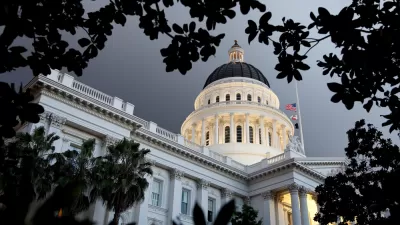The new study determined that carbon forestry offsets, which allow polluters to reduce carbon emissions out-of-state rather than in impacted communities near large pollution sources, is a beneficial climate program.

A controversial California climate program, condemned by environmental justice advocates because it allows large emitters, like oil refineries, to spend funds out-of-state rather than reducing emissions in impacted communities surrounding their facilities, was found to have a positive impact on mitigating climate change.
“Offsets are loopholes for our largest corporate polluters,” said Amy Vanderwarker, co-director of the , in a March Los Angeles Times article on the program.
The offset program is part of California's cap-and-trade program, the only state-run carbon trading program in the nation, that expires at the end of 2020. Offsets were eliminated from SB 775, an unsuccessful bill to continue the program through 2030, but were included in AB 398, which passed the legislature last month with bipartisan support and was signed by Gov. Jerry Brown.
"According to the researchers’ findings, that program is protecting imperiled forests and preventing the carbon they store from being released into the atmosphere," reports energy & environment contributor Chelsea Harvey for The Washington Post.
"Forest offsets, which account for the majority of offsets in California’s cap and trade market, involve forest owners changing the way they manage their land so trees will store more carbon," reports Rob Jordan for the Stanford News on the research published August 14 in the journal, Frontiers in Ecology and the Environment.
This could involve cutting trees less often, reforesting previously forested land or improving forests through various management practices. Under any scenario, professional foresters vet the changes to ensure they are effective.
"The new study suggests some of the concerns surrounding the program may not actually be cause for worry — at least for now," adds Harvey.
Offsets are not only controversial, they are “a super complicated thing to get right,” explains Michael Wara, a former climatologist and environmental law expert at Stanford University who was not involved with the new research, writes Harvey.
“In some sense, forest carbon is trading one kind of co-benefit for another kind of co-benefit,” Wara said. “It’s not strictly a benefit, it’s a trade-off, because we’re going to burn more carbon in California in exchange for storing more carbon elsewhere.”
The new cap-and-trade legislation is sensitive to the concerns of environmental justice advocates. It establishes a "Compliance Offsets Protocol Task Force to provide guidance to the state board in approving new offset protocols ... for the purposes of increasing offset projects with direct environmental benefits in the state while prioritizing disadvantaged communities, Native American or tribal lands, and rural and agricultural regions."
Hat tip to James Brasuell.
FULL STORY: A controversial California effort to fight climate change just got some good news

Alabama: Trump Terminates Settlements for Black Communities Harmed By Raw Sewage
Trump deemed the landmark civil rights agreement “illegal DEI and environmental justice policy.”

Study: Maui’s Plan to Convert Vacation Rentals to Long-Term Housing Could Cause Nearly $1 Billion Economic Loss
The plan would reduce visitor accommodation by 25% resulting in 1,900 jobs lost.

Why Should We Subsidize Public Transportation?
Many public transit agencies face financial stress due to rising costs, declining fare revenue, and declining subsidies. Transit advocates must provide a strong business case for increasing public transit funding.

Paris Bike Boom Leads to Steep Drop in Air Pollution
The French city’s air quality has improved dramatically in the past 20 years, coinciding with a growth in cycling.

Why Housing Costs More to Build in California Than in Texas
Hard costs like labor and materials combined with ‘soft’ costs such as permitting make building in the San Francisco Bay Area almost three times as costly as in Texas cities.

San Diego County Sees a Rise in Urban Coyotes
San Diego County experiences a rise in urban coyotes, as sightings become prevalent throughout its urban neighbourhoods and surrounding areas.
Urban Design for Planners 1: Software Tools
This six-course series explores essential urban design concepts using open source software and equips planners with the tools they need to participate fully in the urban design process.
Planning for Universal Design
Learn the tools for implementing Universal Design in planning regulations.
Smith Gee Studio
Alamo Area Metropolitan Planning Organization
City of Santa Clarita
Institute for Housing and Urban Development Studies (IHS)
City of Grandview
Harvard GSD Executive Education
Toledo-Lucas County Plan Commissions
Salt Lake City
NYU Wagner Graduate School of Public Service



























